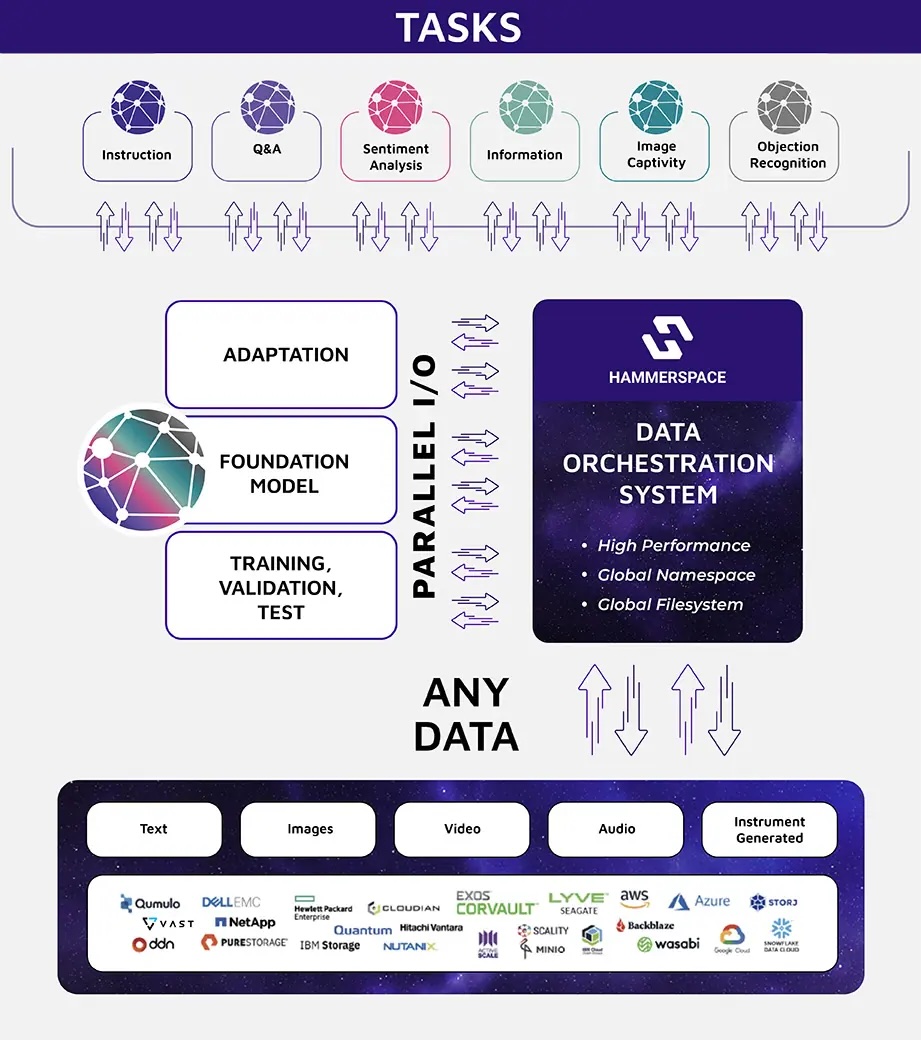Hammerspace recently expanded its offerings by introducing a new line of appliances. Delivering Hammerspace’s data management technology as an appliance simplifies deployment and streamlines the process of purchasing and configuring its solutions.
Hammerspace has long been recognized as a leader in global file and object data management. It provides advanced software solutions that enable organizations to unify, orchestrate, and leverage unstructured data across cloud and on-prem environments.
With its innovative Parallel File System and Global Namespace, Hammerspace has been instrumental in accelerating workflows and simplifying data management for HPC, AI, and distributed enterprise environments.
Hammerspace APpliance
The new Hammerspace appliance combines the company’s software-defined architecture with pre-certified server hardware from a leading vendor, which is fulfilled through Arrow Electronics. This integration allows for a more seamless deployment process, catering to customers seeking a turnkey solution for their data orchestration needs.
Key features of the new Hammerspace appliance include:
- Unified Software and Hardware: The appliance combines Hammerspace’s advanced data orchestration software with high-performance server hardware, allowing users to deploy in a more simplified, plug-and-play manner.
- Pre-Defined Configurations: The appliances are available in six configurations that address various performance and capacity needs, categorized into two types:
- Throughput-Optimized Appliances: These appliances, based on a 1U, 10-drive (1U10) server form factor, are designed to maximize data throughput per rack unit. This is ideal for environments where speed and efficiency in data transfer are critical.
- Flash Capacity-Optimized Appliances: Built with a 2U, 24-drive (2U24) form factor, these configurations are optimized to maximize flash storage per rack unit, making them suitable for use cases that require high-capacity storage and fast data retrieval.
- Small, Medium, and Large Configurations: Both appliance types come in small, medium, and large options, allowing customers to choose based on their specific requirements.

- Scalability and Flexibility: While the pre-defined configurations provide simplified deployment, Hammerspace appliances maintain flexibility, enabling customers to build their own clusters and scale performance and capacity according to their growing needs. This is particularly important for environments with unpredictable or evolving data demands.
Technical Capabilities
Hammerspace’s new appliance line leverages the company’s software innovations, which include:
- Global Namespace: A unified namespace that spans multiple sites and cloud infrastructures, enabling seamless data access and management, regardless of physical location.
- Parallel File System: Hammerspace’s file system is designed to handle massive data workloads, optimizing for performance and resilience.
- Data Orchestration: Hammerspace automates data movement between local and remote compute resources, which is essential for organizations dealing with large volumes of unstructured data.
Use Cases and Applications
The Hammerspace appliance serves various sectors that deal with massive, distributed, or complex data sets, such as:
- High-Performance Computing: HPC environments require massive amounts of data to be processed quickly and efficiently. Hammerspace’s throughput-optimized appliances provide the speed and performance necessary for these workloads.
- Artificial Intelligence and Machine Learning: AI and ML models thrive on large datasets, often scattered across storage systems. Hammerspace’s global namespace ensures that these models can access data in real-time, no matter where it resides, speeding up training and inference processes.
- Enterprise Data Management: Large organizations operating in multiple geographies often face the challenge of siloed data across different storage platforms. Hammerspace’s Global Namespace and data orchestration services simplify data management, unifying these silos and turning unstructured data into actionable business value.
- Media and Entertainment: The media and entertainment industry deals with large volumes of video and audio files and requires high-capacity and high-performance data management solutions. Hammerspace’s flash-optimized appliances ensure that large media files can be stored and accessed with minimal latency.
- Life Sciences and Research: In fields like genomics, where data sets are enormous, and the need for rapid data access is critical, the new Hammerspace appliance offers the storage capacity and the throughput necessary for research organizations to operate efficiently.
Analysis
Hammerspace is expanding into a highly competitive market with its first appliance line. Competitors like NetApp, Dell EMC, and IBM offer hardware-based solutions for enterprise storage, while companies like Snowflake and Databricks focus on cloud-based data management.
What sets Hammerspace apart is its software-first approach that spans both cloud and on-prem environments. Now paired with appliance options for customers who prefer an integrated solution, Hammerspace’s appliances offer the flexibility to scale users’ data management solutions to thousands of nodes while maintaining high throughput and capacity, positioning the company well in both performance and enterprise scalability.
Hammerspace isn’t alone in competing against legacy storage providers with its approach. WEKA and VAST Data play in this space, each having appliance-based configurations. All three companies are finding solid success in servicing the needs of large AI training environments.
The new Hammerspace appliance is a significant move for the company, bridging the gap between software-defined data management and the need for hardware-based performance optimization. These appliances provide a flexible, scalable, and powerful solution for organizations dealing with vast amounts of unstructured data, making them a versatile option for industries such as HPC, AI, and enterprise data management.
For organizations considering data management solutions, particularly those dealing with complex unstructured data environments, Hammerspace appliances offer a compelling combination of performance, scalability, and flexibility. Enterprises should evaluate their current and future data needs and consider deploying Hammerspace appliances to ensure that their data infrastructure is ready to meet the challenges of tomorrow.




